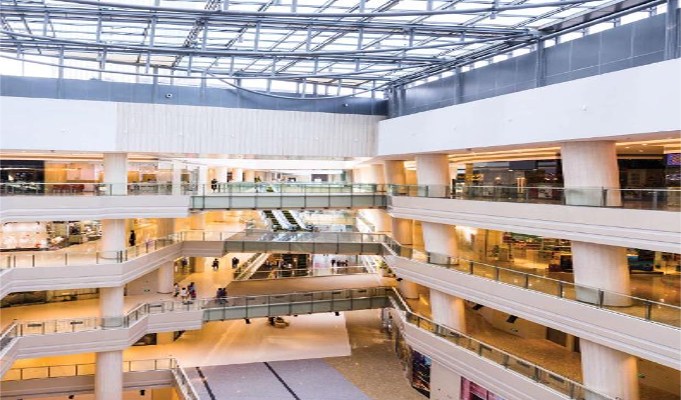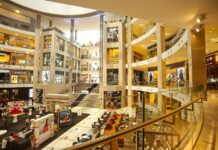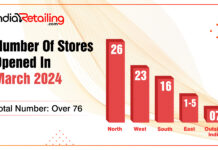India’s e-commerce sector is expected to touch US$ 28 billion by FY 2019-20 on account of an increase in the number of buyers and stable annual spends per consumer, according to a Kotak Institutional Equities report.
“A gradual increase in shopper base, coupled with steady increase in online spends can help the Indian e-tailers reach gross merchandise value of US$ 28 billion by FY 2020. We assume buyer penetration to improve to 18 per cent by FY 2020 from 12 per cent in FY 2016, with annual average online spend to increase by 10-15 per cent year-on-year over the forecast period,” the report states.
The report observes that e-commerce will continue to find more takers, particularly as organised retail penetration remains limited in Tier II and III cities.
So, will shopping malls will loose their sheen in the future since consumers will seek shopping solace through clicks over bricks?
Generally, the success rate of malls varies, usually depending on factors like design and layout, the mall’s brand positioning, location and how well they cater to the needs of their target segments. Also, whether or not they have been able to evolve into family destinations rather than just remaining shopping centres is important.
Mall owners these days are striving hard to provide shoppers with an unparalleled shopping experience combined with never-ending entertainment, fun and food.
MUST READ: 5 malls redefining retail in Delhi
Let’s have a look at what steps a few prominent malls are taking to match the pace of the fast-growing e-commerce industry:-
1Pushpa Bector, Executive Vice President & Head Premium Malls, DLF Mall of India
According to a report, the e-commerce industry will grow at an estimated CAGR of 45 per cent from 2017-2020. With this evolution of e-commerce, what according to you does the future hold for malls in India?
I believe the mall culture has only begun in India, the concept of shopping malls is still evolving rapidly and adjusting to the ever changing market and consumer dynamics. E-commerce and shopping malls in India will co-exist and be complementing each other.
People go to malls for the entertainment and experience value it provides them however one cannot find that on an e-commerce platform. Malls have now become a community centre where individuals spend a lot of time with family and friends, shopping on an e-commerce more often than not is a lonely affair. The mall culture is here to stay as long as the mall developers identify the changing dynamics and make changes to their offering.
Do you think only the strongest malls will survive?
Unfortunately, it is a highly competitive market where only the fittest will survive and to do this malls need to evolve beyond shopping destinations and offer entertainment element to the customers. A strong mall will have all the necessary features such as good brand mix, high quality entertainment and F&B options and focus on providing exceptional experience to customers. Also, digitization will play an important role and use of technology will help in creating next-gen shopping experience for customers.
READ MORE: DLF Ltd promotes Pushpa Bector to Executive Vice President & Head Premium Malls
Digital technology is impacting malls – what technology can we see in the future, that will draw consumers and boost sales in malls?
We have already started witnessing the impact of technology at malls and the role it will play in future. DLF Mall of India is the first mall to adopt the use of technology to revolutionize the retail real estate space in India. Some of the digital features at Mall of India that are drawing footfalls are:
1). Digital Video Walls across the mall for advertising
2). Introduction of online BTL Booking portal: DLF MOI’s path breaking initiative where a brand can book, block, auction, receive invoices, make online payments and acquire gate passes for BTL activations and hiring space
3). Digital Directories that have been designed keeping international best practices in mind to ease the navigation for the customers.
What tech driven steps are you planning on implementing to determine and chart the course of the consumer’s shopping behaviour?
We do a lot of market research and organise focus group sessions to understand consumer’s shopping behaviour. However, we will be setting up in-house team that will be dedicated to understand consumer behaviour using big data analytics. This will enable us to strategize our marketing and advertising campaigns based on the information we derive from analytics.
2Yogeshwar Sharma, Executive Director, Select Citywalk
According to a report, the e-commerce industry will grow at an estimated CAGR of 45 per cent from 2017-2020. With this evolution of e-commerce, what according to you does the future hold for malls in India?
Malls are definitely going to stay as they suit the needs best even during the adverse weather conditions and apart from that it will attract footfall for recreation and experience. However, we are expecting a shift in the buying patterns. E-commerce will be dominated by white goods like electronics whereas customers will still prefer buying fitness and beauty from the malls.
Other steps that mall developers are expected to take are mall resizing, changing category mix and adopting technology.
READ MORE: 6 tips on running a successful mall in India
Do you think only the strongest malls will survive?
It has always been the survival of the fittest. If weaker malls have to be in the race, then they will have to change their selling strategies.
Digital technology is impacting malls – what technology can we see in the future, that will draw consumers and boost sales in malls?
Just like e-commerce, delivery services will soon be started by malls. Digital displays, online inventory are the other steps that we can expect from the malls of the future to boost their sales.
READ MORE: How malls are embracing and leveraging technology
What tech driven steps are you planning on implementing to determine and chart the course of the consumer’s shopping behaviour?
Not only technology, but relevant décor, promotions, and an appropriate brand mix are a steps that we are planning to take to determine and chart the course of a consumer’s shopping pattern. We are also planning to implement technology that e-commerce has successfully adopted in India.
3Siddharth Yog, Chairman, Virtuous Retail
According to a report, the e-commerce industry will grow at an estimated CAGR of 45 per cent from 2017-2020. With this evolution of e-commerce, what according to you does the future hold for malls in India?
With increased consumer spending power, eased norms for retailers, enhanced exposure to media and technology, the consumers’ needs and wants have evolved and they now look out for novel experiences. However, the touch-points remain the same. These shopping malls shall evolve into centres, destinations that cater to the discerning consumers’ demands, fueling the already swelling retail space across India. Further, Tier-II and Tier-III cities will also see a rise in number of malls.
IN PICS: Virtuous Retail launches 500,000 sq. ft. ‘Black Box’ on Whitefield Road
Do you think only the strongest malls will survive?
With retailers introducing standalone stores, increased competition, renewed interest from developers, online retail and more options, only the malls which will cater to the evolving consumers’ needs and offer unique, bespoke experiences shall leave an impression with the consumers and be able to provoke repeat visits. In other words, malls will need to evolve from pure play retail shopping centres into future-proof lifestyle destinations.
READ MORE: Trends that will shape future of shopping malls
Digital technology is impacting malls – what technology can we see in the future, that will draw consumers and boost sales in malls?
Technology, today is advancing at an incredible pace and in an era of unprecedented data deluge, its an arduous task to curate content that’s seamless, efficient and hyper personalized! We foresee malls doing what Google did with Google Adwords by leveraging the unrelated data to understand consumers better and then engage with them with curated and relevant content. The unrelated data could be from social media, wi-fi/ mobile data-based analytics, beacons, events and a host of other consumer data.
What tech driven steps are you planning on implementing to determine and chart the course of the consumer’s shopping behaviour?
There are 3 themes on which we have embarked:
· Analytics out of smartphones usage at the center
· Beacons based proximity marketing
· Tablets and VR headset based high interactive sessions on giant LED screens
Smartphone Data Analytics is one of the many efforts undertaken by us to understand the consumer interests, their preferred dwelling zones, what catches their attention, and also to identify dead-spots at the centre. Most devices with mobile data packs or which are wi-fi enabled, generate heat maps across the center. Tracking is being done through packet sniffing through strategically placed access points across the center with the purpose of developing a self-learning algorithm which aids in identification of hot spots of customer interest. This can be further corroborated along with free wi-fi and foodbox mobile database to generate insights.
Apart from this, beacons and geo-fencing helps us channelise the offerings to the consumers in the centre’s proximity. This is being corroborated with earlier mentioned studies, to curate content relevant for the end consumers.
We are also exploring the use of giant screens at all our centers to leverage the next generation VR headsets for high interactive gaming as well as for social shopping.
With a healthy attitude and creative use of technology and our considerable institutional experience in the retail and real estate sectors both in India as well as globally, we hope to make the consumer shopping experiences at our centres unique and memorable. That finally, is what will keep us evolving too.
4Abhishek Bansal, Executive Director, Pacific Mall
According to a report, the e-commerce industry will grow at an estimated CAGR of 45 per cent from 2017-2020. With this evolution of e-commerce, what according to you does the future hold for malls in India?
During the last few years, the retail has witnessed a substantial growth and the Indian retail industry has made substantial progress aligning a vast range of items from across categories under one roof. Due to liberalization of the FDI policy, major international and global players have now entered the retail space with ambitious plans to expand in the future years across verticals and cities. Though growing smartphone penetration and burgeoning of online retail platforms have created diversions offline retail is here to stay. In fact an eMarketer report states that 90 per cent of retail sales still take place in store.
READ MORE: Shopping centres find new tech ways to ‘wow’ customers
In fact, the future of retail is Omnichannel. This trend towards an Omnichannel strategy will enable retailers to re-think their business strategy in order to tap the best of both worlds and maximise on footfalls.
Do you think only the strongest malls will survive?
No doubt, e-commerce is here to stay and grow but there is room for all. The Indian consumer is spending their money 30 per cent more than the earlier generation and we need to encourage them to spend more by offering the right mix of experience, brands and services. India is the fifth largest preferred retail destination globally and is also the highest in the world in terms of per capita retail store availability making it a dynamic and fast growing sector in India today.
IN PICS: Size Does Matter – 5 biggest shopping malls of India
Gone are the days when shopping malls were considered as retail centers offering multitudes of retail shopping outlets as today consumers visit shopping malls not only to shop designer clothes and accessories but are also looking for an unparalleled shopping experience combined with never-ending entertainment, fun and food.
Digital technology is impacting malls – what technology can we see in the future, that will draw consumers and boost sales in malls?
Being a premium shopping and leisure destination with very high footfall, the experience that a customer has once he or she enters the gate is of prime importance to us. We have invested in state of the art security management service and surveillance systems and they are one of the biggest enablers for us in maintaining our performance and meeting customer expectations.
We have deployed some of the latest innovative programs in technology such as the completely automated system for logging and tracking of complaints, use of advanced software for mall management and operations for tracking, audits and data management, centralized one point system to track consumption of all utilities throughout the mall and an international mall management company to help us maintain these high standards at mall.
What tech driven steps are you planning on implementing to determine and chart the course of the consumer’s shopping behaviour?
We regularly partner with research agency and relevant analyst bodies to keep track of the continuously changing buying behaviour and dynamic retail environment. This involves study of consumers buying behaviour retail outflow trend, footfall analysis and changing market trend.
5Amaan Fakih, CEO, Malls at Runwal Group
According to a report, the e-commerce industry will grow at an estimated CAGR of 45 per cent from 2017-2020. With this evolution of e-commerce, what according to you does the future hold for malls in India?
A shopping mall is developed not with a sustenance plan of five years, but with a long term objective to survive at least for a few decades. E-commerce is an external element that has impacted shopping malls businesses. However, e-commerce should not be perceived as a threat for the brick-and-mortar model, but should be looked upon from a positive perspective as it helps reach customers who were earlier out of reach of brick-and-mortar players. Thanks to the e-commerce industry, for tapping the unreachable customers as once a customer is converted into a lead and starts using a certain brand, the customer base for those brands increases, for both e-commerce and brick-and-mortar models.
Though the growth of e-commerce has been projected to reach 45 per cent, at the ground level, the impact of the special discounts doled out by e-commerce players has considerably reduced and this should create a level playing field where e-commerce is looked upon for convenience and accessibility rather than just a format that gives great discounts.
READ MORE: The evolution of shopping malls in India
Although e-commerce is a competition to brick-and-mortar players, the latter continues to have a strong foundation and will remain in the future too. But yes, there will be some changes in the nature of offerings by brick-and-mortar models which over a period of time will become more experiential, and cannot be replicated across the e-commerce platforms due to certain limitations to the experience that one can have of various products and services. Shopping malls will also shape up to offer more entertainment and lifestyle services to compete more efficiently with the e-commerce platforms.
Do you think only the strongest malls will survive?
The stronger the property, better are the chances of its survival. The properties that are not strong enough will shut down soon. Developers should understand and evaluate the opportunities that surround the market catchment area.
For example, if there is a 1 million sq.ft mall with a 2 lakh sq.ft development in process, this will not translate into the fact that the latter property may shut down in the near future. What will impact its success is how the management transforms or mould their strategies for the existence of the shopping mall. The mall will then have to see how best they can change their proposition and feed itself of the larger interest created in the 1 million sq.ft. The developer will have to choose whether to transform it into a specialist mall, value mall or specialised mall such as only for women, etc.
MUST READ: How 100% FDI in e-commerce can help malls
Digital technology is impacting malls – what technology can we see in the future, that will draw consumers and boost sales in malls?
The adaption and use of technology to the benefit of the property is essential in ensuring consistent footfalls over the years. Today, customers are becoming more and more tech savvy, and hence the technology that shopping mall developers adopt plays an important part in transforming customers’ expectations into reality.
Developers should invest in technology to study consumer behaviour, choices and preferences in order to plan their mall dynamics better, to suit their requirements. Technology today comes in various forms such as loyalty apps, tracking devices such as wi-fi and bluetooth, which are all deployed by most developers.
Shopping malls are moving away from mere infrastructure that generates rental yield to projects that understand the retail business. Therefore, more and more malls are getting down to business, understanding retailing, patterns of business, partnering with retailers and increased revenue sharing formats with retailers and connecting the eventual yield of the property to the potential sales that can be delivered by their retail format.
READ MORE: Are high streets taking these pointers from malls
6Mohammad Ali, COO – Retail, Prestige Group
According to a report, the e-commerce industry will grow at an estimated CAGR of 45 per cent from 2017-2020. With this evolution of e-commerce, what according to you does the future hold for malls in India?
We strongly believe that the brick and mortar will not die, e-commerce might have some impact but its not going to take away the business from the malls. As most of the shopping happens impulsively, its not planned. The way a mall can present a store/product/merchandise is very different from the online, because there are several other factors, senses- touch, feel, smell. The entire ambience that malls create while shopping- the fun-loving and friendly.
Do you think only the strongest malls will survive?
Definitely yes. But we need to define the strength –It is the combination of brands, size, have the opportunity to change brands, have strongest tenants, strongest brand mix, large size, well-managed, and technologically updated will survive.
Digital technology is impacting malls – what technology can we see in the future, that will draw consumers and boost sales in malls?
There is a lot of opportunity in Digital technology. The important is to track customers profile and their needs. We are focused on making the customer’s mall visit a memorable one in terms of giving them access to the best brands for shopping, the best of food, fun activities, and the best parking facility along with many other amenities. The technology that will be able to communicate all these offerings and get timely feedback and loyalty from customers, is the technology which will prove to be the best in future.
What tech driven steps are you planning on implementing to determine and chart the course of the consumer’s shopping behaviour?
We always plan for the tech driven steps that will help to understand the customers on the longer run. Customer experience-the experience that he/she is going through within the mall, also understanding the needs of the customer and most importantly the needs of the market. Using the data that is relevant, today having the data which will give us relevant insights about the consumer so that we can offer the best and Help tenants also understand to offer the best.














